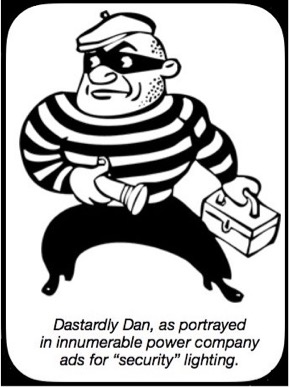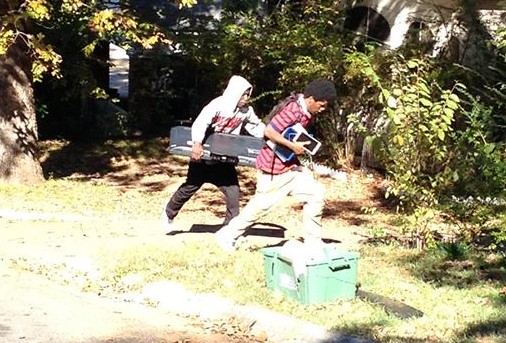A Little Truth About “Security Lighting”.

The modern world is full of lights that automatically turn on at dusk and shine all night long. They just as automatically remove money from your bank account and add carbon to the atmosphere, while polluting the night with unnecessary light, especially if they are not properly shielded like the one shown here. What do they accomplish?
With the help of Dastardly Dan here, with his striped shirt, mask, and flashlight, utility companies sell electricity during off-peak hours with a message that implies your home is at risk of being burgled in the night unless you have a “security light” shining somewhere on your property; that somewhere usually being where they already have a pole.
A modest sum each month to keep this guy away is a bargain, right? But, have you ever asked yourself exactly how lighting some part of your yard is supposed to protect you and your property from this dastardly fellow? And while you are thinking about it, why does he need that flashlight if you are lighting things for him? Wouldn't he be more conspicuous if he did need a flashlight?
Sometimes these fixtures are called “night watchers”. A clever marketing moniker. But, that underlines the fallacy in the whole concept, as lights can't watch anything. Whose eyes will make use of the "night watcher's" light after you and your neighbors have retired for the night? Who besides D. Dan that is?
Some might say, "Oh, Dastardly Dan will see the light, and be frighten away". The problem with this theory is criminals are not cockroaches, they need light like everyone else. In fact, the word Lunatics comes from the time before artificial lighting, when all the bad and wild stuff that humans did at night happened near the full moon. People tended to stay home at night with no moon until we invented streetlights.

So, is Dan frightened or facilitated by that “night watcher” light? Time for some facts:
1) Most burglaries occur during the day when burglars can see what they are doing. Darkness is not required to be inconspicuous if you leave the striped shirt and mask at home.(i)
(How bright does it need to be if daylight is not a deterrent? This photo on the right, and videos below it, are broad daylight events here in central Arkansas.)

2) There is no objective evidence that simply lighting someplace provides security in the absence of active surveillance. Indeed, experts agree, always-on "static" lighting may just as well facilitate crime as discourage it. (ii)
(Right - UPS man should have set this out in the sun instead of the dark porch. Surely, that would have deterred light-sensitive Dastardly Dan.)
3) Experience and controlled studies alike have shown that outdoor lighting can attract crime, suggesting that criminals, like the rest of us, are afraid of the dark and need light to get around. (iii)
(Right - Plenty of light for D. Dan to see his opportunity. No flashlight needed. Perhaps closing the garage door and locking the car would have been more effective than the light.)
4) For residential security purposes, lighting on a motion sensor is more likely to be effective. Not only does it not attract or facilitate criminals, but it signals possible detection when it comes on. (iv)
(Right - Plenty of static all night light to allow this D. Dan to case this neighborhood for easy pickings. But it is a video camera and motion sensor light that provides deterrence.)
To be sure, there are times and places where lighting is needed for safety and security, virtually any place where people can be expected to be out and about or where there is active surveillance. A porch or walkway lighting when expecting guests, for safety more than security, and driveway lighting on a motion sensor. Lighting in a parking lot or pedestrian way when in use, or when a security watch is posted. But we see lights burning on front porches in urban residential areas, or on poles around rural homes late at night when all the good guys with eyes are asleep.
Even when and where useful, to be effective, proper lighting practices should be followed to avoid excessive illumination, uneven lighting, and shadows, as well as light trespass. Real security lighting requires design and planning. (iv)
Your typical utility company does not have lighting or security expertise. Instead a "night watcher" or flood light is going to be thrown on an existing pole, send light in every direction only to peter out into shadows, which along with glare produced by a typically cheap unshielded fixture will likely degrade visibility as much as improve it. Such lighting only provides an expensive security illusion.
So why do so many people pay for security lights? In part, because utilities have heavily marketed them; coal-fired power plants don't have throttles and these light burn electricity at off-peak hours during the night.
Lighting can enhance security in the presence of potential surveillance, or in occupied locations, so it is easy to sell the idea that lighting inherently provides security. We impulsively buy into the idea without considering the wasted money, the damage to the environment, the esthetics of losing the night, the impact on our neighbors, or the simple futility of lighting random areas into the wee hours of the night when no one is observing, except perhaps Dastardly Dan. Light is simply not an antiseptic for crime.


So, the truth is dusk to dawn lighting is insecurity lighting – a night light for grownups. Like a security blanket, security lighting makes some of us feel better even if it has no actual benefit. So, the thief here is Ready Kilowatt who leads you to believe light can protect your property for the price of a trickle of money from your bank account to his, month after month, year after year while contributing to the collective harm we are doing to the environment. (vi)
If you are really worried about crime, there are things you can do like security systems and light fixtures on motion sensors as recommended by lighting professionals. (vii)
Get smart, turn the night light off, and use the money to light and protect your home properly. You will be safer, a little richer, the world less polluted, and the stars closer.
i http://www2.fbi.gov/ucr/cius2009/data/table_07.html
ii A Report to the United States Congress, by the National Institute of Justice: “We can have very little confidence that improved lighting prevents crime, particularly since we do not know if offenders use lighting to their advantage.”
iii The Chicago Alley Lighting Project: Final Evaluation Report April 2000, Illinois Criminal Justice Information Center. http://www.icjia.state.il.us/public/pdf/ResearchReports/Chicago%20A lley%20Lighting%20Project.pdf. A controlled study comparing crime rates between lighted and unlighted Chicago alleys. Results showed a clear increase in all categories of crime in the lighted alleys when compared to the same alleys before they were lighted and the unlighted comparison alleys.
Illumination Engineering Society, ES PR-33-14, 4.6.2, “lighting alone cannot provide security…increasing lighting levels does not necessarily increase security…A common error with security lighting is to assume that static lighting (lighting that is always on) is required…Using lighting that is controlled by motion sensors or similar devices which turn light on when a potential threat is detected can increase security.
http://www.dailygazette.com/weblogs/hartley/2011/nov/14/dimming-lights/ Reporting that towns in New York area turning down or off-street lighting late at night to save money find crime falls.
http://jech.bmj.com/content/69/11/1118 British Journal of Epidemiology and Community Health. DOI: 10.1136/jech-2015-206012. Finds widespread implementation of practices to dim or turn off street lighting late at night has no impact on crime other than a small decrease in violent crime.
http://www.peninsula.wednet.edu/conservation/Energy/dark%20campus.htm A Washington state school district saves almost a million dollars a year on electricity by turning campus lighting off at night and finds vandalism and burglary drops to near zero.
iv Illumination Engineering Society, IESNA G-1-03 7.2.10
v Illumination Engineering Society, IESNA G-1-03
vi (AMA) REPORT 4 OF THE COUNCIL ON SCIENCE AND PUBLIC HEALTH (A-12) Light Pollution: Adverse Health Effects of Nighttime Lighting.
vii Crime Prevention Through Environmental Design, www.cpted.net
